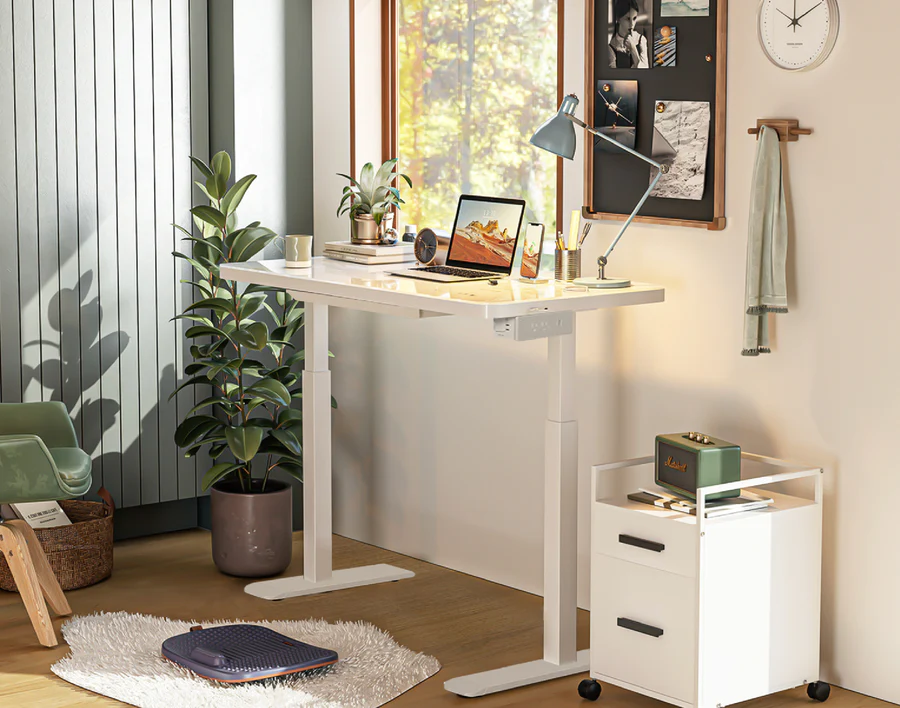In the dynamic landscape of modern workplaces, standing desks have evolved from a quirky novelty to a staple for health-conscious professionals. This shift has sparked a debate: are standing desks worth the investment? Let’s delve into the facts.
Understanding Standing Desks: A Historical Perspective
The idea of standing while working isn’t a 21st-century innovation. Historical luminaries like Leonardo da Vinci and Winston Churchill were known to work at elevated desks. However, the recent surge in standing desk popularity is a reflection of our times, echoing a growing consciousness about workplace ergonomics and well-being.

In the digital era, many of us are tethered to our desks for extended periods, raising concerns about our sedentary lifestyles. Some hail the standing desk as the antidote to prolonged sitting. As more workplaces and homes adopt this furniture piece, it’s crucial to cut through the hype and genuinely answer the question: are standing desks worth it? What tangible benefits do these desks offer, and what trade-offs should we consider?
The Upsides of Standing Desks: A Closer Look
In this section, we’ll explore the compelling reasons that make standing desks, such as the Branch Standing Desk, more than just a stylish furniture choice—they could be a game-changer for your daily work routine.
Boosting Productivity
One of the most celebrated benefits of standing desks is the potential boost in productivity. Standing can induce a state of alertness and focus, a subtle shift from the laid-back sitting posture, nudging our minds into a more proactive gear. If you’ve ever wondered if standing desks are worth it from a productivity perspective, this newfound energy might just be your answer.
Potential Health Benefits
Research studies suggest that breaking the cycle of prolonged sitting can be beneficial. Long hours of sitting have been indirectly linked to a range of health concerns. Standing desks offer users the flexibility to alternate between sitting and standing, potentially reducing the risks associated with sedentary behavior. However, it’s essential to strike a balance—standing all day isn’t the answer either, but the adaptability of standing desks allows users to find a rhythm that suits their needs.
Ergonomic Advantages
Ergonomics is about creating a workspace that aligns with our body’s natural mechanics. A well-designed standing desk can assist users in maintaining correct posture, ensuring that screens are at eye level, feet are flat on the ground, and arms are positioned correctly.
Maximizing Workspace Efficiency
In today’s rapidly evolving urban spaces, optimizing one’s workspace is crucial. Standing desks are the epitome of spatial efficiency. Their design often incorporates a sleek and minimalist approach, catering perfectly to smaller offices or home workspaces.
Flexibility in Work Environment
The dynamic nature of today’s work culture demands flexibility. Standing desks embrace this need effortlessly. Many come equipped with easy-to-adjust mechanisms, allowing users to seamlessly modify desk height or orientation based on the task at hand.
The Downsides of Standing Desks: A Balanced Perspective
While the allure of standing desks is undeniable, it’s vital to approach them with a balanced perspective. Understanding potential challenges can ensure you make an informed choice before you take the leap and integrate one into your workspace.
Initial Adjustment Period
Transitioning to a standing desk can initially introduce a certain level of discomfort or unfamiliarity. It’s a deviation from what our bodies are used to, especially if we’ve been accustomed to sitting for extended periods. Some might experience leg fatigue or a longing to revert to the old desk during the first few days. It’s natural. However, like any change, this too has a curve, and with time and persistence, your body adapts.
Investment Cost
Embracing a standing desk is not just a shift in posture; it’s an investment in well-being. While the initial outlay for a high-quality standing desk might be higher than a conventional desk, seeing it as a long-term investment is essential.
Ergonomic Challenges
Without the right setup, one might inadvertently introduce ergonomic challenges. It’s not just about standing; it’s about standing right. The desk’s height, the position of your computer screen, and where your arms rest, all ensure the standing experience is beneficial and not a strain.
Choosing the Right Desk: Focusing on Benefits
A standing desk’s value isn’t in its stature, but in the benefits it offers. While features and specifications can dazzle, the real essence lies in how they enhance your work experience. Consider how a desk can seamlessly integrate into your daily routine when exploring options. Does it allow an easy transition between sitting and standing? Is it adjustable to your height, ensuring an optimal viewing angle for your computer screen? These considerations matter.
Conclusion: Making the Decision
So, are standing desks worth it? They offer an array of benefits, from potential productivity boosts to health considerations. Like any choice, it’s about weighing the pros and cons and, more importantly, understanding your needs. With the right setup and mindset, a standing desk can indeed be a game-changer. As you ponder this investment, remember that it’s not just about a desk; it’s about elevating your work experience. Here’s to choices that stand tall and make a difference!
